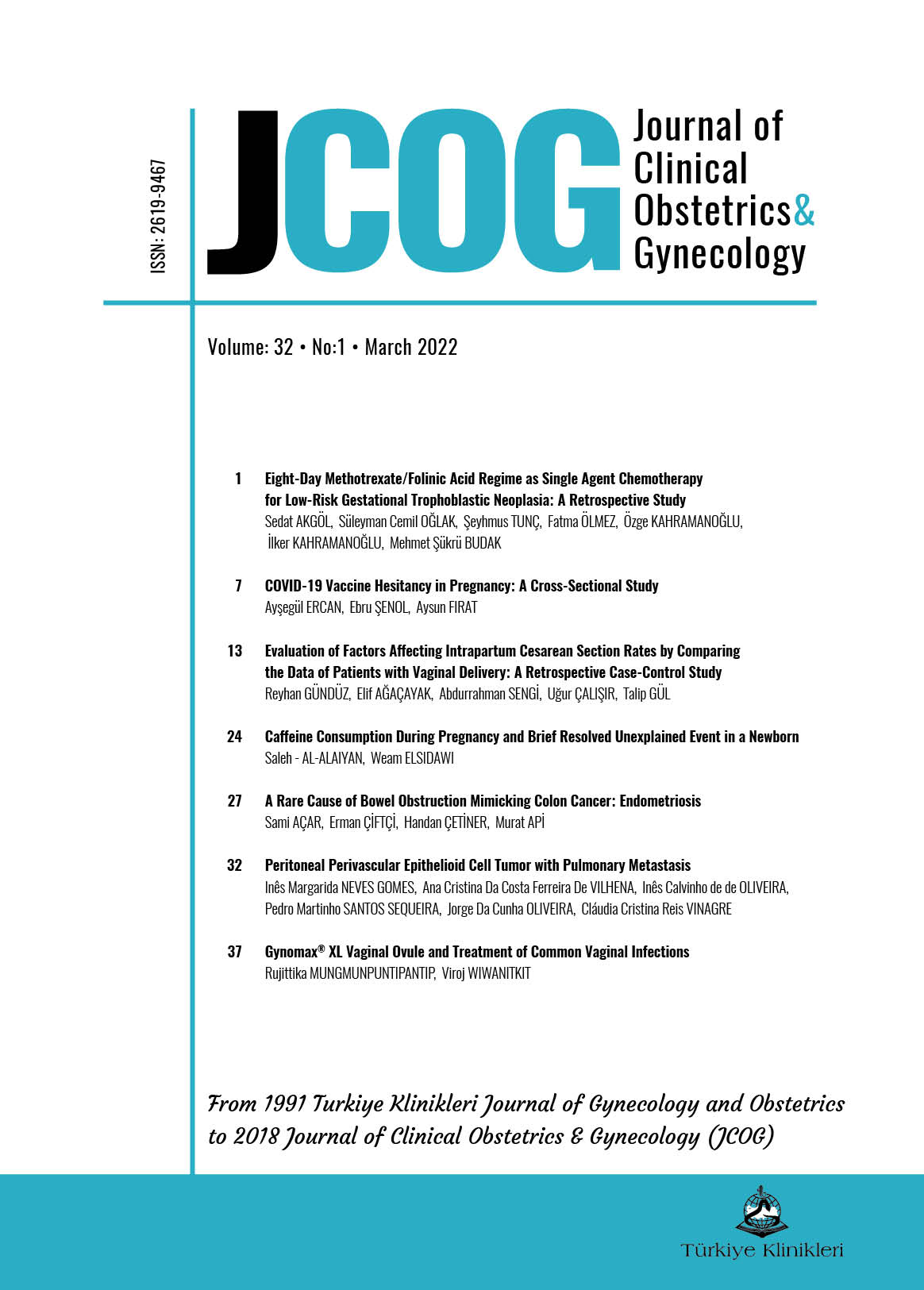Open Access
Peer Reviewed
CASE REPORTS
1583 Viewed1050 Downloaded
Peritoneal Perivascular Epithelioid Cell Tumor with Pulmonary Metastasis
Received: 13 Oct 2021 | Received in revised form: 21 Jan 2022
Accepted: 07 Feb 2022 | Available online: 15 Feb 2022
JCOG. 2022;32(1):32-6
DOI: 10.5336/jcog.2021-86575
Article Language: EN
Article Language: EN
Copyright Ⓒ 2025 by Türkiye Klinikleri. This is an open access article under the CC BY-NC-ND license (http://creativecommons.org/licenses/by-nc-nd/4.0/)
ABSTRACT
Perivascular Epithelioid Cell Tumor (PEComa) is part of an extremely rare family of mesenchymal tumors. We present a case of Peritoneal Pecomatosis with pulmonary metastases in a 35-year-old woman, with previous multiple myomectomies, uterine artery embolization and severe pos-partum hemorrhage. Given previous medical history, two years after birth a routine transvaginal ultrasound was performed which showed nonspecific, multiple, highly vascularized solid nodules in the uterus, peritoneum and rectus abdominis, confirmed by Magnetic Resonance Imaging. The nodules were surgically removed and diagnosed as multifocal PEComa with positive expression for estrogen receptors. The disease progressed with pulmonary metastasis and it was decided to start systemic therapy with Tamoxifen (20 mg daily). During the following two-year close surveillance, the patient was clinically and imagiologicaly stable, without disease progression. PEComas are very unusual tumors and the differential diagnosis include fibroids. In estrogen receptor positive tumors, Tamoxifen may be considered as a therapeutic option.
Perivascular Epithelioid Cell Tumor (PEComa) is part of an extremely rare family of mesenchymal tumors. We present a case of Peritoneal Pecomatosis with pulmonary metastases in a 35-year-old woman, with previous multiple myomectomies, uterine artery embolization and severe pos-partum hemorrhage. Given previous medical history, two years after birth a routine transvaginal ultrasound was performed which showed nonspecific, multiple, highly vascularized solid nodules in the uterus, peritoneum and rectus abdominis, confirmed by Magnetic Resonance Imaging. The nodules were surgically removed and diagnosed as multifocal PEComa with positive expression for estrogen receptors. The disease progressed with pulmonary metastasis and it was decided to start systemic therapy with Tamoxifen (20 mg daily). During the following two-year close surveillance, the patient was clinically and imagiologicaly stable, without disease progression. PEComas are very unusual tumors and the differential diagnosis include fibroids. In estrogen receptor positive tumors, Tamoxifen may be considered as a therapeutic option.
REFERENCES:
- Le P, Garg A, Brandao G, Abu-Sanad A, Panasci L. Hormonal manipulation with letrozole in the treatment of metastatic malignant pecoma. Curr Oncol. 2014;21(3):e518-20. [Crossref] [PubMed] [PMC]
- Acosta AM, Adley BP. Predicting the behavior of perivascular epithelioid cell tumors of the uterine corpus. Arch Pathol Lab Med. 2017;141(3):463-9. [Crossref] [PubMed]
- Okamoto S, Komura M, Terao Y, Kurisaki-Arakawa A, Hayashi T, Saito T, et al. Pneumothorax caused by cystic and nodular lung metastases from a malignant uterine perivascular epithelioid cell tumor (PEComa). Respir Med Case Rep. 2017;22:77-82. [Crossref] [PubMed] [PMC]
- Dimmler A, Seitz G, Hohenberger W, Kirchner T, Faller G. Late pulmonary metastasis in uterine PEComa. J Clin Pathol. 2003;56(8):627-8. [Crossref] [PubMed] [PMC]
- Bosincu L, Rocca PC, Martignoni G, Nogales FF, Longa L, Maccioni A, et al. Perivascular epithelioid cell (PEC) tumors of the uterus: a clinicopathologic study of two cases with aggressive features. Mod Pathol. 2005;18(10):1336-42. [Crossref] [PubMed]
- Vang R, Kempson RL. Perivascular epithelioid cell tumor ('PEComa') of the uterus: a subset of HMB-45-positive epithelioid mesenchymal neoplasms with an uncertain relationship to pure smooth muscle tumors. Am J Surg Pathol. 2002;26(1):1-13. [Crossref] [PubMed]
- Ross C, Sharma S, Louca O, Scurr M, Hayes A, Judson I. A patient presenting with a perivascular epithelioid cell tumor in the broad ligament: a case report. J Med Case Rep. 2011;5:383. [Crossref] [PubMed] [PMC]
- Weinreb I, Howarth D, Latta E, Ghazarian D, Chetty R. Perivascular epithelioid cell neoplasms (PEComas): four malignant cases expanding the histopathological spectrum and a description of a unique finding. Virchows Arch. 2007;450(4):463-70. [Crossref] [PubMed]
- Fink D, Marsden DE, Edwards L, Camaris C, Hacker NF. Malignant perivascular epithelioid cell tumor (PEComa) arising in the broad ligament. Int J Gynecol Cancer. 2004;14(5):1036-9. [Crossref] [PubMed]
- Italiano A, Delcambre C, Hostein I, Cazeau AL, Marty M, Avril A, et al. Treatment with the mTOR inhibitor temsirolimus in patients with malignant PEComa. Ann Oncol. 2010;21(5):1135-7. [Crossref] [PubMed]
- Liu JL, Lin YM, Lin MC, Yeh KT, Hsu JC, Chin CJ. Perivascular epithelioid cell tumor (PEComa) of the uterus with aggressive behavior at presentation. Hematol Oncol Stem Cell Ther. 2009;2(3):426-30. [Crossref] [PubMed]
- Sobiborowicz A, Czarnecka AM, Szumera-Ciećkiewicz A, Rutkowski P, Świtaj T. Diagnosis and treatment of malignant tumours. Oncol Clin Pract. 2020;16(1):22-33. [Crossref]
- Urban T, Kuttenn F, Gompel A, Marsac J, Lacronique J. Pulmonary lymphangiomyomatosis. Follow-up and long-term outcome with antiestrogen therapy; a report of eight cases. Chest. 1992;102(2):472-6. [Crossref] [PubMed]
- Schiavina M, Contini P, Fabiani A, Cinelli F, Di Scioscio V, Zompatori M, et al. Efficacy of hormonal manipulation in lymphangioleiomyomatosis. A 20-year-experience in 36 patients. Sarcoidosis Vasc Diffuse Lung Dis. 2007;24(1):39-50. [PubMed]
- Casanova A, Ancochea J. Linfangioleiomiomatosis: novedades terapéuticas [Lymphangioleiomyomatosis: new therapeutic approaches]. Arch Bronconeumol. 2011;47(12):579-80. Spanish. [Crossref] [PubMed]
MENU
POPULAR ARTICLES
MOST DOWNLOADED ARTICLES





This journal is licensed under a Creative Commons Attribution-NonCommercial-NoDerivatives 4.0 International License.










